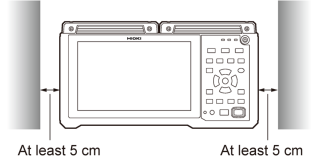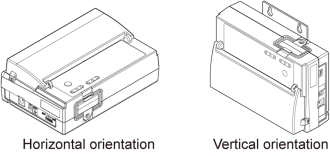Operating Precautions
Be sure to follow the precautions listed below in order to use the instrument safely and in a manner that allows it to function effectively.
Use of the instrument should conform not only to its specifications, but also to the specifications of all accessories, options, and other equipment in use.
Checking safety prior to use
|
DANGER |
|---|
|
Inspect the instrument and verify proper operation before use. Use of the instrument while malfunctioning could result in serious bodily injury. If you find any damage, contact your authorized Hioki distributor or reseller. For more information about inspections, see Inspection of the instrument. |
For more information about the instrument’s operating temperature and humidity range and its storage temperature and humidity range, see Specifications.
|
WARNING |
|---|
|
Do not install the instrument in locations such as the following:
Doing so could damage the instrument or cause it to malfunction, resulting in bodily injury. |
|
CAUTION |
|---|
|
Do not place the instrument on an unstable stand or angled surface. Doing so could cause the instrument to fall or overturn, resulting in bodily injury or damage to the instrument. Do not bend or pull on cables at temperatures of 0°C or lower. Since cables become rigid, doing so could damage the insulation or cause a wire break, resulting in electric shock. Do not unplug data cables while the instrument is sending or receiving data. Doing so could damage the instrument. |
|
Turn off the instrument and computer before connecting or disconnecting data cables. Failure to do so could cause the instrument to malfunction or damage it. Use the same ground for the instrument and computer. Connecting data cables while there is a potential difference between the instrument and computer’s ground levels could cause the instrument to malfunction or damage it. |
IMPORTANT
-
Please take care not to change the ambient temperature around the terminal blocks of measurement modules. If the terminal blocks are subject to wind, such as that blown from a ventilator or an air conditioner, measurement errors will arise during temperature measurement with thermocouples.
-
When moving the instrument to a location with a significantly different temperature, allow the instrument to sit for at least 60 minutes before starting measurement.
Do not block vent openings. (Leave at least 5 cm of space on the left and right sides of the instrument in order to keep its temperature from rising.)

The instrument is classified as a Class A device under the EN 61326 standard. Use of the instrument in a residential setting such as a neighborhood could interfere with reception of radio and television broadcasts. If you encounter this issue, take steps as appropriate to address it.
Installing the wireless modules
Place the wireless module in either of the following orientations.
-
Horizontal orientation: Place with its front side (the input terminals) up.
-
Vertical orientation: Place with its upper side (the Z3230 or Z3231 attached) up.
If the wireless module is placed in other orientations, the system may yield measured values that do not meet the accuracy specifications.

|
DANGER |
|---|
|
Do not input a voltage that exceeds the measurement module’s maximum input voltage, maximum rated terminal-to-ground voltage, or maximum rated channel-to-channel voltage to any channel. Do not input a voltage to a resistance measurement terminal. Measurement modules have different maximum input voltages, maximum rated terminal-to-ground voltages, and maximum rated channel-to-channel voltages. For more information about maximum input voltages, maximum rated terminal-to-ground voltages, and maximum rated channel-to-channel voltages, see Specifications. Doing so could cause electric shock or damage the instrument. Do not use the instrument or measurement modules to measure a main power supply circuit. The U8550, U8551, U8552, U8553, LR8530, LR8531, LR8532, and LR8533 measurement modules have terminal-to-ground voltages that qualify as CAT II, but they cannot be used to perform CAT II, CAT III, or CAT IV measurement. Never input a CAT II, CAT III, or CAT IV voltage across measurement terminals. Doing so could cause electric shock or damage the instrument. |
|
Turn off power to the circuit under measurement before performing measurement. Failure to do so could cause electric shock or damage the instrument. |
|
WARNING |
|---|
|
Do not allow the instrument to get wet. Do not operate the instrument with wet hands. Doing so could cause electric shock. |
Effect of induction potential
Displayed values can frequently fluctuate due to induction potential even when no voltage is applied. This, however, is not a malfunction.
Shipping precautions
Store packaging materials for future use. You will need the packaging materials when shipping the instrument.
|
CAUTION |
|---|
|
Do not subject the instrument to vibration or mechanical shock while transporting or handling it. Do not drop the instrument. Doing so could damage the instrument. |
When transporting the Z1007 Battery Pack on an aircraft
-
The Z1007 Battery Pack uses rechargeable lithium-ion batteries.
-
The transport of lithium-ion batteries by air is subject to regulations in accordance with United Nations recommendations.
-
If you need to repair or calibrate any device that uses the Z1007 Battery Pack or to transport such devices by air, contact transport firms or airlines.
Precautions related to disc usage
-
Exercise care to keep the recording surface of the disc free of dirt and damage. If you need to label the disc, for example with text, use a marker with a soft tip.
-
Store discs in protective cases. Avoid exposing discs to direct sunlight, high temperatures, or high humidity.
-
Hioki is not liable for any computer system issues that arise in connection with the use of this disc.
Wireless LAN
The LR8450-01 Memory HiLogger and Z3230 or Z3231 Wireless LAN Adapter use radio communications in the 2.4 GHz band. No regulatory permit is necessary to use the product, but caution should be exercised with regard to the following:
|
DANGER |
|---|
|
Do not use the instrument in proximity to medical devices such as pacemakers. Radio waves from the product may affect operation of the pacemaker or other medical device, causing it to malfunction or damaging it. |
|
WARNING |
|---|
|
Do not use the instrument with medical equipment, nuclear power equipment or devices, aerospace equipment, transport equipment or devices, or other equipment or devices being used in applications that affect human life, or with equipment, devices, or systems that require an advanced level of reliability. Hioki is not liable for any bodily injury or damage that arise as a result of the use of the product in such applications. |
IMPORTANT
-
Do not use the LR8450-01 and its wireless modules near other wireless communications devices that use the same frequency band. Doing so may result in communications instability or affect the operation of other devices.
-
Install the LR8450-01 and any wireless modules (Z3230 or Z3231 Wireless LAN Adapters) so that they are not more than roughly 30 m apart.
-
Install the LR8450-01 and any wireless modules so that there are no obstructions (walls, metal materials, etc.) between them. Failure to do so may result in communications instability or reduce the communications range.
-
Communications between the LR8450-01 and its wireless modules (Z3230 or Z3231 Wireless LAN Adapters) are encrypted, but the confidentiality of information sent and received is not guaranteed. Hioki is not liable for any leaks of measured values caused by wireless communications.
-
The LR8450-01 and its wireless modules (Z3230 or Z3231 Wireless LAN Adapters) give off radio-wave radiation. Use of radio communications requires a permit in the country of use. Use of the instrument outside the countries and regions listed in the included “Precautions Concerning Use of Equipment That Emits Radio Waves” may constitute a violation of applicable laws, resulting in penalties.
-
Placing the LR8450-01 and its wireless modules (Z3230 or Z3231 Wireless LAN Adapters) on the floor or ground will reduce the communications range. The communications range can be extended by moving the devices away from the floor or ground, for example by placing them on a workbench or stand.
Troubleshooting communications issues
You can review how to deal with issues involving communications between the instrument and wireless modules using the QUICK SET feature.
“1.16 Configuration Navigator (Quick Set)” in the Instruction Manual.
Checking communications status
You can check the status of communications on your wireless network.
“9.4 Using the Wireless Modules (LR8450-01 Only)” in the Instruction Manual.